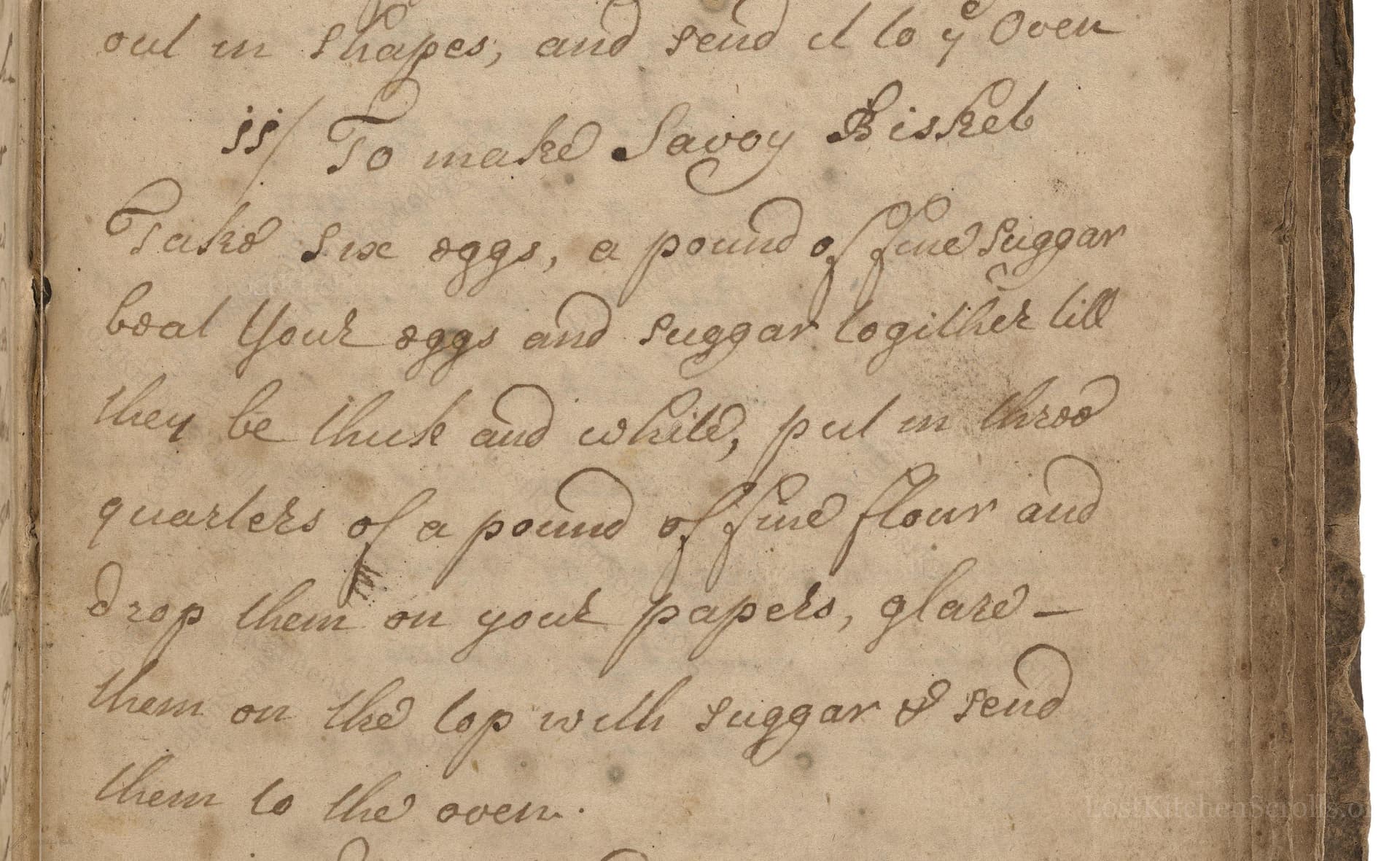To Make Savoy Bisket
From the treasured pages of Receipts for cookery and pastry work
Written by Mrs. Johnston

To Make Savoy Bisket
"Take Six eggs, a pound of fine suggar beat Your eggs and suggar together till they be thick and white, put in three quarters of a pound of fine flour and Drop them on your papers, glase them on the top with suggar & send them to the oven."
Note on the Original Text
Early 18th-century English recipe manuscripts were concise, assuming the reader's familiarity with basic techniques. Precise measurements translated here from 'a pound' of sugar and 'three quarters of a pound' flour to metric for today’s cook, but would have been measured by weight with hand-held, springless scales. The spelling of 'suggard' (sugar), 'eggs,' and 'glase' (glaze) reflects period orthography; capitalisation was erratic and punctuation sparse. Recipes rarely mentioned oven temperature or timings—these were judged by observation and experience. The instruction to 'beat till thick and white' hints at the era’s understanding of the emulsifying power of eggs and sugar, even before the advent of electric mixers.

Title
Receipts for cookery and pastry work (1700)
You can also click the book image above to peruse the original tome
Writer
Mrs. Johnston
Era
1700
Publisher
Unknown
Background
A delightful compilation of 18th-century recipes gathered by Mrs. Johnston herself, promising a charming journey through the flavors and culinary traditions of the early 1700s.
Kindly made available by
Folger Shakespeare Library
This recipe hails from the early 18th century, compiled by Mrs. Johnston circa 1700, and captures the transition in baking towards refined sponge biscuits—a specialty inspired by the French and Italian tradition of light, egg-based sweets. Known as 'Savoy Bisket,' these biscuits were likely served at fashionable tea-tables or used in grand desserts. During this period, sugar was still a luxury but increasingly found its way into recipes thanks to trade expansion. Eggs were prized for their ability to transform mixtures into airy, elegant confections, a practice made possible by improved kitchen tools and growing culinary sophistication among the gentry.

Cooks in 1700 would have used a large, deep earthenware or pewter bowl for beating the eggs and sugar, employing bundles of twigs or whisks made from birch as early predecessors to the balloon whisk. Flour would be sifted through linen or a fine sieve. The 'papers' mentioned are thick sheets of writing paper, greased and spread on flat baking sheets (or even directly on the oven floor). Baking occurred in a wood-fired oven, with careful management of the fire and heat to avoid burning such delicate treats. A small spoon or knife would be used to drop mounds of dough onto the paper, and sugar would be sprinkled by hand. There were no thermostats, so experience and intuition determined when the biskets were done.
Prep Time
20 mins
Cook Time
12 mins
Servings
24
We've done our best to adapt this historical recipe for modern kitchens, but some details may still need refinement. We warmly welcome feedback from fellow cooks and culinary historians — your insights support the entire community!
Ingredients
- 6 large eggs
- 2 cups plus 3 tablespoons fine caster sugar (plus extra for glazing)
- 2 3/4 cups plain (all-purpose) flour, finely sifted
Instructions
- Start by preheating your oven to 340°F (170°C) and lining a baking tray with baking parchment.
- Separate 6 large eggs and combine the yolks and whites, then whisk them together with 2 cups plus 3 tablespoons of fine caster sugar until the mixture is thick, pale, and ribbon-like—a process that takes some time, but crucial for the lightness of the biscuit.
- Sift in 2 3/4 cups of fine wheat flour (plain/all-purpose), folding it gently to retain the airy texture.
- Drop spoonfuls of the batter onto your prepared baking paper, giving the biscuits space to expand.
- Dust the tops with a little extra sugar for that charming glazed look, then bake for 10–12 minutes or until lightly golden.
- These delicate sponge biscuits, reminiscent of Italian savoiardi or ladyfingers, are ready to be enjoyed as they are, or as a base for trifle or other desserts.
Estimated Calories
68 per serving
Cooking Estimates
Preparing the batter takes about 20 minutes, while baking the biscuits takes another 12 minutes. Each biscuit has around 68 calories, and you will get 24 biscuits from this recipe.
As noted above, we have made our best effort to translate and adapt this historical recipe for modern kitchens, taking into account ingredients nowadays, cooking techniques, measurements, and so on. However, historical recipes often contain assumptions that require interpretation.
We'd love for anyone to help improve these adaptations. Community contributions are highly welcome. If you have suggestions, corrections, or cooking tips based on your experience with this recipe, please share them below.
Join the Discussion
Rate This Recipe
Dietary Preference
Main Ingredients
Culinary Technique

Den Bockfisch In Einer Fleisch Suppen Zu Kochen
This recipe hails from a German manuscript cookbook compiled in 1696, a time whe...

Die Grieß Nudlen Zumachen
This recipe comes from a rather mysterious manuscript cookbook, penned anonymous...

Ein Boudain
This recipe comes from an anonymous German-language manuscript cookbook from 169...

Ein Gesaltzen Citroni
This recipe, dating from 1696, comes from an extensive anonymous German cookbook...
Browse our complete collection of time-honored recipes



